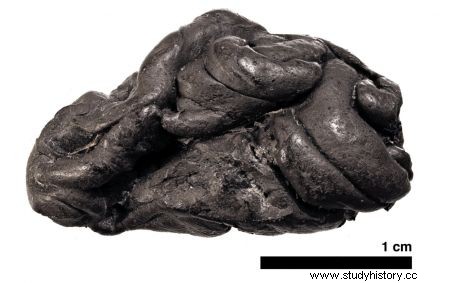"Lola" had blue eyes and dark skin, lived 5,700 years ago in present-day Denmark, and likely ate duck and hazelnuts, analysis of a chewed-up, DNA-encrusted piece of birch reveals.

Artistic representation of Lola
Brown skin and hair, blue eyes, mouth bacteria similar to ours, and a meal presumably consisting of duck and hazelnuts:while chewing a piece of birch 5,700 years ago, one of our distant ancestors, renamed "Lola ", left a lot of information there in the form of remarkably preserved DNA. This is the first time that an entire ancient human genome has been extracted from anything other than human bones. This Danish work is published in the journal Nature Communications .
A chewed piece of birch tree stuffed with DNA from 5,700 years ago
At Syltholm, an important excavation site in southern Denmark, archaeologists came across an unimpressive object, yet one that turned out to be particularly valuable:a piece of birch with tooth marks, 5,700 years old (Late Mesolithic / Early Neolithic). It is more precisely birch pitch, a brown substance obtained by heating the bark of the tree. For experts, this material was once used as an adhesive, the mash allowing it to be flexible, or for the natural antiseptic properties of birch.
Brown skin and hair, blue eyes, mouth bacteria similar to ours, and a meal presumably consisting of duck and hazelnuts:while chewing a piece of birch 5,700 years ago, one of our distant ancestors, renamed "Lola ", left a lot of information there in the form of remarkably preserved DNA. This is the first time that an entire ancient human genome has been extracted from anything other than human bones. This Danish work is published in the journal Nature Communications .
A chewed piece of birch tree stuffed with DNA from 5,700 years ago
At Syltholm, an important excavation site in southern Denmark, archaeologists came across an unimpressive object, yet one that turned out to be particularly valuable:a piece of birch with tooth marks, 5,700 years old (Late Mesolithic / Early Neolithic). It is more precisely birch pitch, a brown substance obtained by heating the bark of the tree. For experts, this material was once used as an adhesive, the mash allowing it to be flexible, or for the natural antiseptic properties of birch.

"Chewing gum" in birch pitch at the origin of this work. Photo credits:Theis Jensen.
On closer inspection, researchers find remarkably conserved DNA on the chewed pitch. It is precisely chewing that traps DNA in birch, "where it is preserved due to the aseptic and hydrophobic properties" pitch, "which inhibit both microbial and chemical breakdown" , explain the authors in the publication. And this DNA is not only human. In addition to that of the person who originated the chew, the researchers also found microbial DNA, which they identified as coming from his oral bacterial flora, as well as green-necked duck and hazelnut. To them, these last items are leftovers from his most recent meal!
A dark-haired woman with blue eyes, close to hunter-gatherers
Human DNA reveals a woman, brown in skin and hair, with blue eyes. "This combination of physical traits has been previously observed in other European hunter-gatherers, suggesting that this phenotype was widespread in Mesolithic Europe and that the adaptive spread of light skin pigmentation in European populations did not occur. is produced only later in prehistory" , deduce the authors in the publication. "It is amazing to have obtained a complete ancient human genome from something other than bones “, reacts in a press release Professor Hannes Schroeder of the Globe Institute at the University of Copenhagen, who led the research.
"Lola" was "genetically closer to western continental European hunter-gatherers than to farmers in central Scandinavia" , suggesting "that the genetic impact of Neolithic farming communities in southern Scandinavia may not have been as instantaneous or pervasive as previously thought" and that "genetically distinct hunter-gatherer groups survived much longer than previously assumed" , analyze the authors in the publication.
On the artistic representation of Lola (in illustration of this article), she seems particularly young. "There is (so far) no way to tell age based on the genome. The image is partly a product of the artist's imagination but also because many these chewing gums bear small dental impressions suggesting that they were chewed by children “, explains to Sciences et Avenir the researcher Hannes Schroeder, who led this work.
Analyze prehistoric bacterial flora to understand our own
As for the microbial oral flora, it also contains valuable information. First, the majority of families of bacteria identified "are considered part of the normal microflora of the human mouth and upper respiratory tract" , write the authors. More valuable, some of these flora bacteria are known today to cause, under certain conditions, health problems such as periodontitis (inflammation of the gums), or even pneumonia. The Epstein-Barr virus, causing herpes, was also found. For these potential pathogens, comparing their old genetic material with new "can help us understand how pathogens have evolved and spread over time, and what makes them particularly virulent in a given environment. At the same time, it can help predict how a pathogen will behave in the future and how it might be contained or eradicated" , explains Hannes Schroeder.
